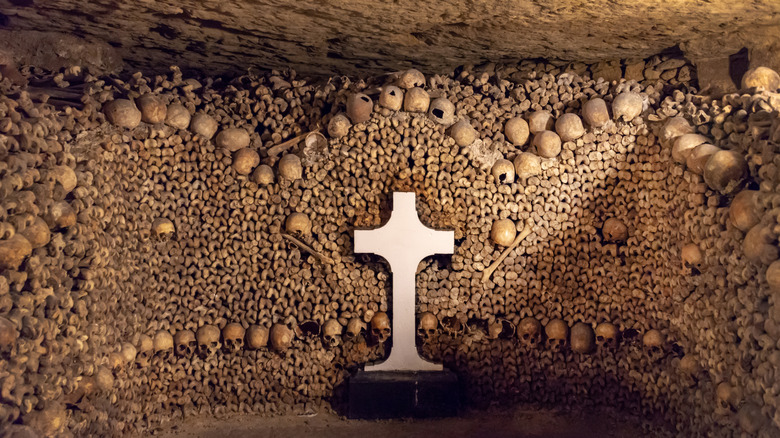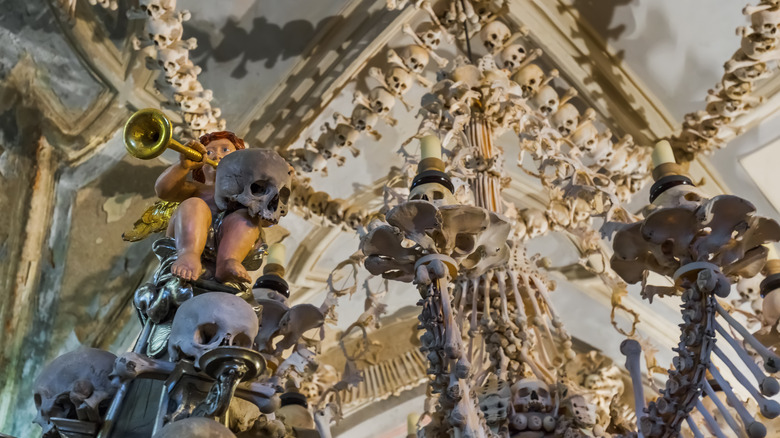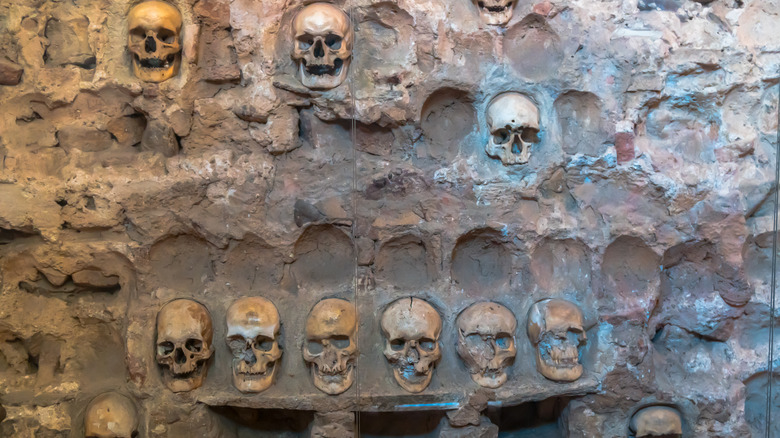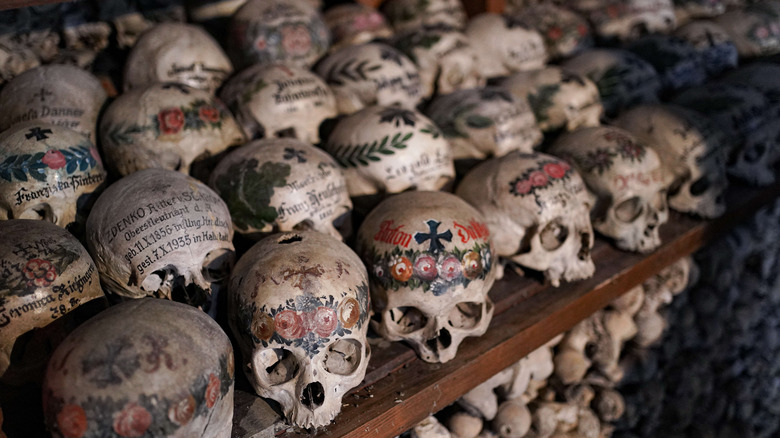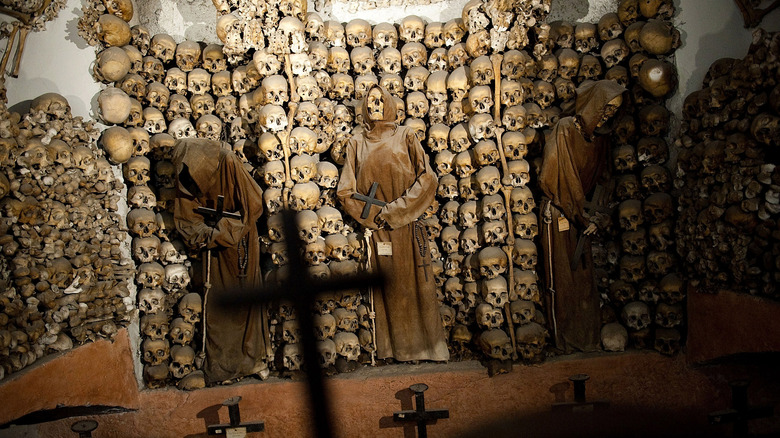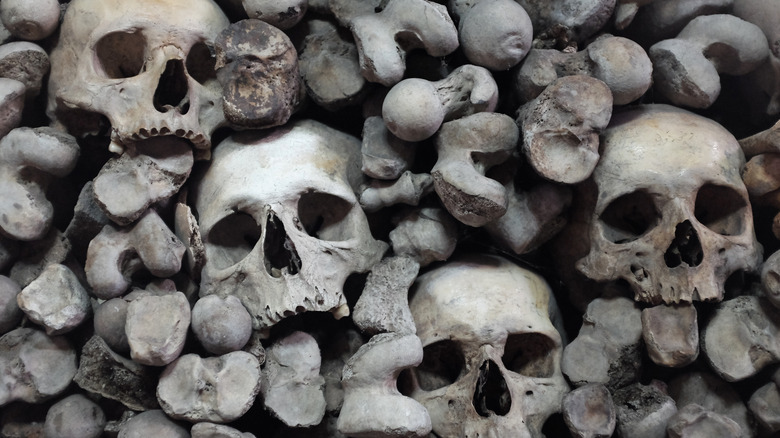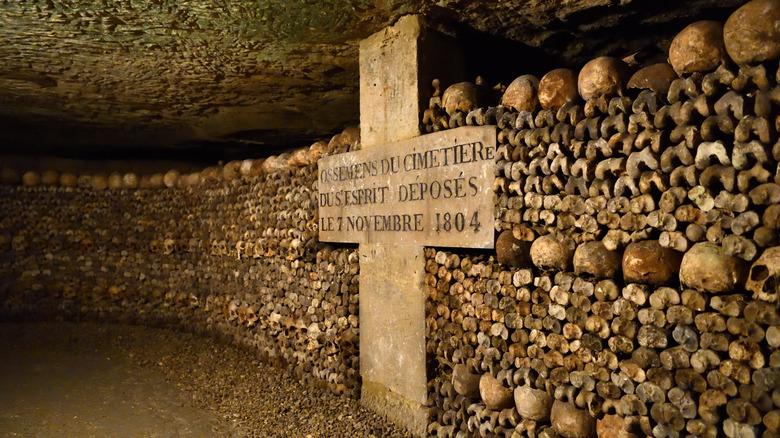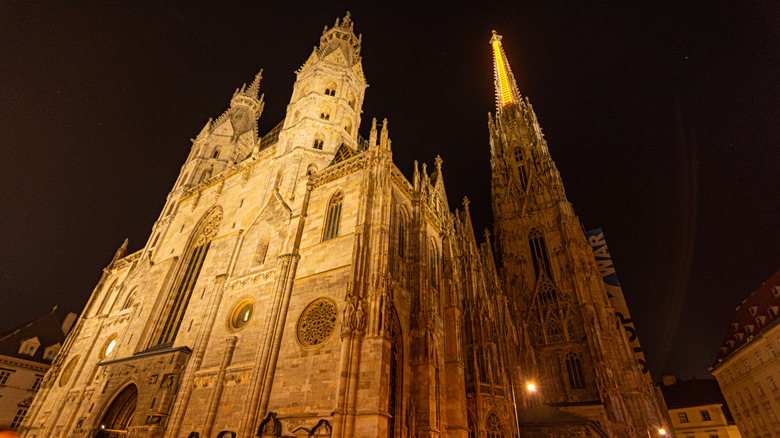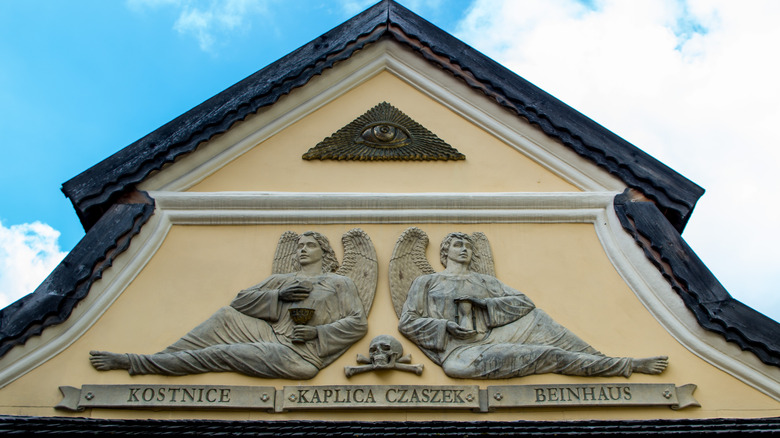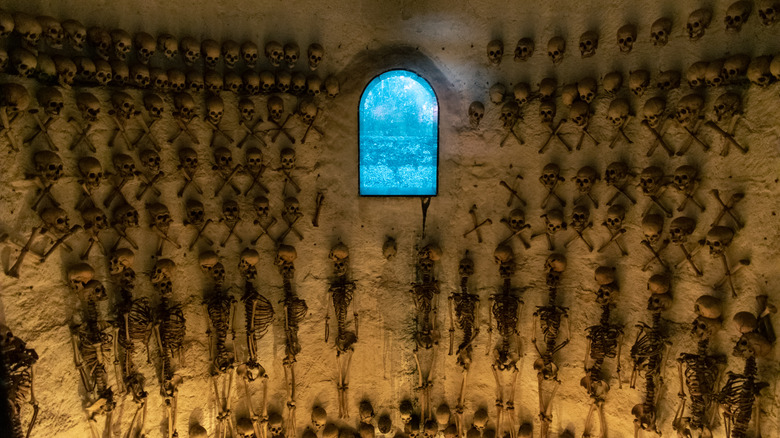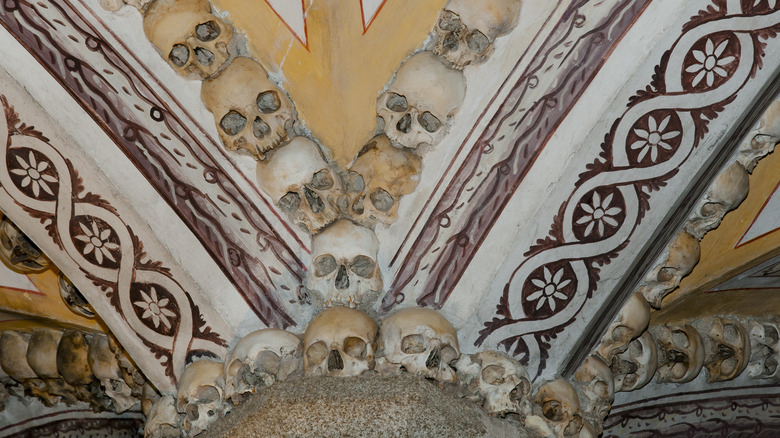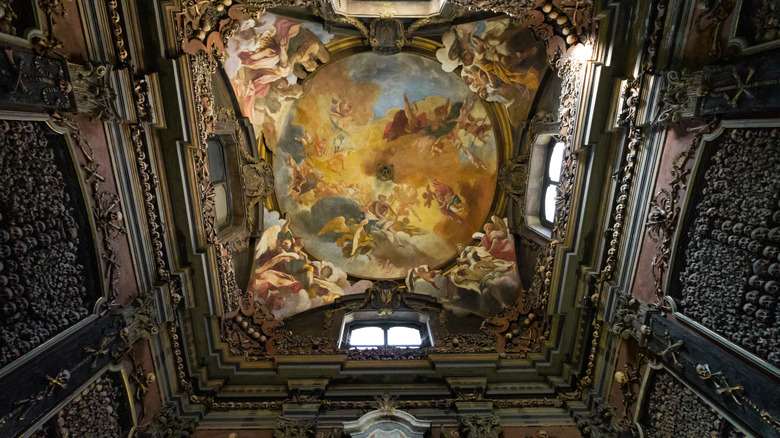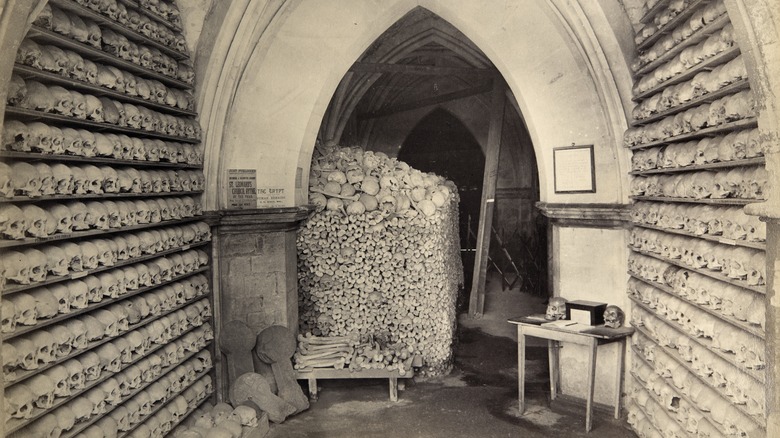Hauntingly Beautiful And Macabre Ossuaries Around The World
For those based in the United States, we'll only see human remains in a class, a laboratory, or the artificial kind used to decorate for Halloween's spooky season. The idea of looking at the bones of our ancestors creeps many people out. After all, we bury our dead and hide them away in cemeteries. Out of sight means out of mind — no need to contemplate our mortality. Other places worldwide find no need to hide their ancestors' remains, and sometimes, they honor them in decorations among the most hauntingly beautiful and macabre ossuaries.
An ossuary is a place to house bones. Now, just throwing bones into a building and calling it a day would be dull, and it really doesn't honor the dead in a way many cultures would see fit for those who came before us. That's why the ossuaries on this list have used the bones to build, to create, to make something worth looking upon when remembering the past and contemplating our ends. They're gorgeous displays, and if you're faint of heart, they may just creep you out a little.
Sedlec Ossuary in Kutná Hora, Czechia
Sedlec Ossuary in Kutná Hora has done some seriously fascinating things with the bones of the dead. The Sedlec graveyard was around before the ossuary, but when the Black Death spread through Europe, the bodies began piling up at the Sedlec door. With so many remains needing housing, something had to be done with them. That's when creating the Bone Church went into full swing. It took about three centuries to give their bones their final design, and now, Sedlec Ossuary is one of the most famous ossuaries in the world.
Garlands of skulls and crossbones hang from the ceiling of the Church of Bones. The archways are made from similar remains. Dangling in the center of the chapel is a chandelier crafted from skulls, femurs, pelvic bones, mandibles, and vertebrae. A coat of arms constructed entirely of human remains hangs before a dome display of the dead. Ornate crosses, giant goblets, and pretty much every fixture were once living people who'd later be turned into beautiful works of art after their deaths. Two classical cherubs, their adorable faces ready to blow their horns and signal the end times, sit upon columns dappled with skulls. With over 40,000 deceased in the hands of artist carpenter František Rint, Sedlec Ossuary was turned into one of the most stunning bone displays in Europe, and it's a perfect dark tourism destination.
Skull Tower in Nis, Serbia
For roughly 500 years, Serbia and the Ottomans clashed over the southern city of Niš. The Ottomans held the town, but the Serbs wouldn't go down without a fight. Cue the Battle of Čegar in 1809. A relatively small Serbian army stood against the Ottoman Empire to reclaim Niš. The occupiers pressed the Serbian band hard, forcing them to retreat to a trench. The Serbs were overpowered and outnumbered and running out of options fast. That's when a soldier by the name of Stevan Sinđelić made a call that turned the tides, albeit at a terrible cost. He fired a round into a container of black powder, which ignited an explosion that took out the surrounding Ottoman forces. Unfortunately, the explosion also took out all of the Serbian soldiers in the trench.
There were 952 Serbian soldiers killed in Sinđelić's desperate action, and they're commemorated today in the Tower of Skulls, where their remains have become part of the structure itself. The 58 remaining skulls peak out from the walls like bricks in mortar, which they pretty much are. To view this macabre piece of Serbian history, you'll have to pass through a more modern set of walls first since a chapel was built around it sometime after the Serbians regained control of the region.
Hallstatt Charnel House in Hallstatt, Austria
St. Michael's Chapel in Hallstatt, Austria, is surrounded by beauty. The village of Hallstatt sits on a stunning lake of the same name, with views of Alpine peaks on every side. The scenery is straight out of a fairytale. The chapel sits among grave markers in the Halstatt cemetery, and though these grave markers are charmingly carved wooden statues and plaques, they only account for a small piece of the dark beauty this chapel has to offer. Inside and underground, in the Hallstatt Charnel House, is where the real macabre attraction lies.
This ossuary is significantly smaller than many of the others on this list. The bonework doesn't build intricate tunnels or high arches. It's only a single room with one wall of skulls, but each of these skulls is as unique as the people who left them behind. These remains were initially buried in the cemetery and later dug up so their graves could be repurposed for the newly dead. To help preserve their identities and honor the dead, they were given second funerals, where the skulls are handpainted and stored in the charnel house with so many others. Each skull has its own design, reflecting an artist's particular flair and the period in which they were decorated.
The Crypts of Santa Maria della Concezione dei Cappuccini in Rome, Italy
The Roman chapel of Santa Maria della Concezione dei Cappuccini is one of many in Rome, and like most of the others, it's quite old, dating back to the early 17th century. The chapel is part of the Capuchin sect of Catholicism, which faced a lot of adversity throughout the 16th century during the Catholic Reformation. They were harassed by other religious chapters and banned from spreading their ideas. This has a part to play in the history of Santa Maria della Concezione dei Cappuccini, though the church admits it made up much of its origin due to missing historical context and clues. Either way, they believe the church was created by Capuchins running from persecution in France, looking for a place to hide out, and — ta-dah! — the chapel and the ossuary were born.
The crypt below the chapel holds the remains of nearly 4,000 Capuchin brothers in six different macabre works of art. Practically mummified remains in friar robes are mingled among walls of bone art, whole skeletons of former friars, skulls, and informative plaques. It's a little eerie since the remains look almost like death incarnate, but the creative positioning gives visitors a sense that the dead are still living in the realm beyond.
The Church of St. Peter and Paul in Melník, Czechia
The many incredible ossuaries in Czechia are some of the oldest found worldwide. The Church of St. Peter and Paul in Mělník is no exception to this rule. The history of this church and ossuary begins a millennia ago when The Church of St. Peter and Paul was just that, a simple church with no real macabre appeal. Like many churches at the time, it had a small cemetery attached. The ossuary wasn't built until the 1500s, inspired by the overflowing graveyard in the wake of the Black Death. You'll notice that many European ossuaries began with the immense spacial burden posed by the overflowing dead during the plague. Necessity breeds innovation.
With internal walls of bone, a bone altar, and a large cross similarly built of human remains, there's no wonder this ossuary is sometimes referred to as "The Chapel of Bones." It's said to contain the remains of over 10,000 people, all arranged in a space small enough to be cozy and intimate. If, of course, you have the ability to find lingering with the dead "cozy." But the beauty is there, whispering among the artful arrangements of bone and the symbols they make — the anchors and crosses and heart shapes.
Catacombes de Paris in Paris, France
The Catacombes de Paris, or Paris Catacombs, are collectively one of the most famous bone structures in the world. These catacombs are built from human remains that once belonged to former cemeteries in the Paris area, brought together to line almost 4 square miles of underground tunnels. Millions of Parisian dead lay in permanent rest within this ossuary, several stories under the surface of France's capital city.
The Paris Catacombs aren't as old as some of the ossuaries on this list, but since the remains come from all over Paris, it's likely the bones themselves are. The construction of these hauntingly beautiful underground tunnels began in the late 1700s to combat health concerns with the traditional cemeteries in the area. Now, tourists can book visits to smell the earth and reflect on our human lineage of mortality present in the artistic lining of alternating rows of skulls and bones before climbing the Eiffel Tower.
There should be some level of warning here since the Catacombes de Paris contain some of humanity's greatest natural fears. The tunnels can be dark, the remains are housed in an underground confined space, and the reminder of death is present at every twisting turn of the tunnels. So, though the Catacombs don't present a danger to visitors, some might find the experience overwhelming — even if it is one of the coolest underground attractions in the world.
Stephansdom Crypt in Vienna, Austria
Stephansdom, also known as St. Stephan's Cathedral, is almost 1,000 years old. It's a hallmark of Vienna, Austria, and it's beautiful in every sense of the word. The external structure is reminiscent of Medieval and Gothic times when hand-shorn stone was used to build stunning spires and intricate designs, though only part of it is original, thanks to a fire during the Battle of Vienna. The Cathedral was essentially pieced together through the ages, as was the crypt below its foundation.
The crypt and catacombs of Stephansdom are filled with remains that span centuries. Many of the bones found in the artwork were collected by prison laborers from surrounding cemeteries during the late 1700s. Other exhibits, such as the tomb of Duke Rudolf of Austria, date back much further, into the 1300s. Among the remains are the organs of deceased monarchs, royalty, and nobility. The crypts span as much in the difference of appearance as they do in time. The Ducal Crypt contains ornate coffins holding noble remains, whereas other parts of the catacombs have wall displays constructed of barebones. Coffins, urns, and openly presented skeletal remains can be found throughout. It truly is both haunting and gorgeous in a macabre sort of way.
The Skull Chapel of St. Bartholomew's Church in Kudowa-Zdrój, Poland
St. Bartholomew's Church in Kudowa-Zdrój, Poland, truly lives up to its moniker, "The Skull Chapel." Compared to other ossuaries on this list, The Skull Chapel seems rather dinky in size –- roughly the size of an efficiency apartment –- but within its small perimeter are the remains of more than 3,000 people. The bulk of the remains were victims of the Thirty Years War of the Seven Years War, pulled from mass burial sites and re-interned either in this macabre beauty or below the Church of St. Batholomew in the crypts where over 20,000 deceased lay at rest.
Inside The Skull Chapel is a small altar where a gilded and detailed statue of the Christian messiah hangs in his crucifixion, surrounded by a handful of skulls. It's a stunning image, though, to some, it's muted by the realization that this is a mass grave despite its artistic design. The internal structure from the wooden floor upwards is wholly lined with human bones. The wall behind the altar is stacked entirely with skulls, while the other walls are built of alternating layers of long bones, which appear to be primarily humeri, femurs, and skulls. The design for the ceiling above invokes old pirate flags as the wooden planks are hung with row upon row of skulls and crossbones. This chapel was initially meant to be a place of silent reflection, and the decore allows for nothing but.
Tomb of Enrique Torres Belón in Lampa, Peru
Enrique Torres Belón was a politician during a time in Peru known as The Great Drought in the 1950s. This happened shortly after a rewiring of the political system in the country. Though the drought was of the physical kind, the economy took a brutal hit, and the nation's politicians were forced to come together to handle Peru's problems. Torres Belón, being an engineer as well as a politician, worked on a crucial irrigation system, among other things. When he died, he was buried in a tomb that became one of the newest ossuaries. It's both radically bizarre and pretty neat. And Enrique Torres Belón designed it himself.
Torres Belón and his wife rest in a dome-shaped tomb with inner walls lined with the hanging skeletons of people exhumed from local burial sites. Sitting on the floor is a sizeable black cross-piece made of marble. The whole tomb, minus the remains, looks clean and practically new, blending the eerie sensations of an ancient crypt with modern appeal.
The Chapel of Bones at the Church of St. Francis in Évora, Portugal
The Chapel of Bones in Évora, Portugal, was first created by Franciscan monks in the 1500s. As is typical for ossuaries, its purpose was to house remains from overflowing cemeteries, honoring the dead by turning them into works of art.
The corners of the support pillars within the chapel are stacked with bones from the floor up, cornered and topped with skulls of the dead. Walls of remains surround visitors under the stone roof, inlaid with arched designs of set straight bones. The vaulted ceilings are masterfully painted with flowing images of plants intertwined with death's scythes and his charges, each section framed in garlands of human crowns. It's a reverent place, if not a bit on the spooky side.
The Church of St. Francis is a national landmark, and it doubles as an art nerd's paradise. Beyond the Chapel of Bones, the church offers stunning displays of guilded statuary, paintings, and other religious iconography, not to mention the architecture. The beauty isn't limited to the macabre.
San Bernardino alle Ossa in Milan, Italy
Before the San Bernardino ossuary was built in Milan, Italy, the site was a cemetery where the deceased from a nearby hospital were buried. This was in the 1100s, and the world wasn't quite as attuned to population growth as we are nowadays. By the early 1200s, the cemetery was overfilled. The remains of the dead were then stored in an underground vault until the ossuary proper was built in the late 1600s. Among other macabre attractions, San Bernardino alle Ossa houses the remains of Christopher Columbus' mother's family.
Beneath the heavenly fresco of angels looking down from the ceiling are ornate pillars adorned with fixtures of human bone. Large sections of each wall are split into squares of skeletal remains, with centerpieces of towering crosses created from strategically positioned skulls. The upper corners of the internal walls are bound with bone crests, and the jagged aspects of the architecture are ornamented with trails of crania and empty eye sockets. The painting above the altar, depicting what seems to be Death visiting a deceased body, draws the atmosphere to a point that whispers "memento mori."
St. Leonard's Church Ossuary in Kent, England
With the remains of about 4,000 people housed within its walls, the Ossuary at St. Leonard's Church in Kent, England, is the largest ossuary in all of Britain. What's particularly interesting about this ossuary is that no one seems to know whose remains are housed here. Legend says these unidentified bones are the result of Viking raids gone wrong and the triumph of the British who overtook them. The truth is likely something more mundane. Graveyards fill up. Bones are exhumed and replaced with the more recently deceased. Those bones are stored and forgotten, identities lost to time. And this is likely what happened at St. Leonard's.
Within the ossuary below the church, single skulls framed by femurs stand out like lanterns in the wall of a darkened tunnel, their pale visages drawing the eye from the more clustered areas of the macabre display. In arched displays, other skulls are positioned with numbers stamped across their cranium from profiling efforts by researchers attempting to give the remains some sense of identity. Jaws sit on a table, awaiting to be united with their perspective maxillas someday.
